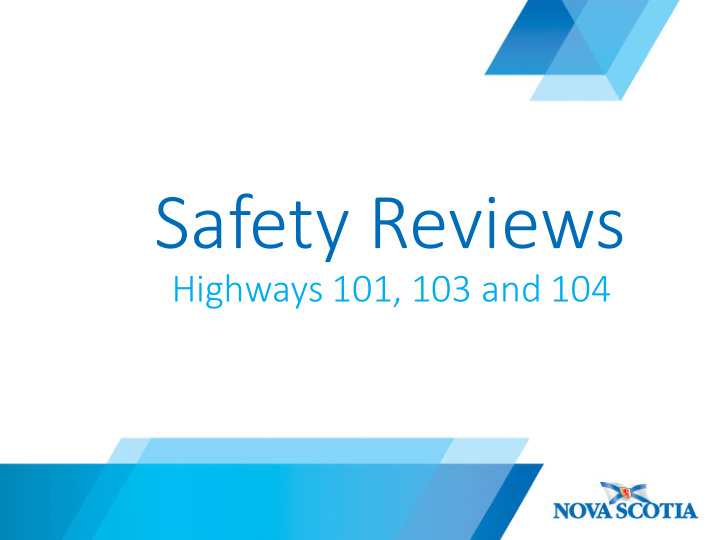



Safety Reviews Highways 101, 103 and 104
Purpose of Road Safety Reviews (Highways 101, 103 and 104) To identify current and projected safety deficiencies and to develop short and medium term improvement plans to help ensure acceptable levels of service and safety performance until such time longer term improvements such as twinning can be undertaken. 2
Study Sections Hwy 101 - Digby (Exit 26) to Weymouth North (Exit 27) - 24 km (2 Lane, 5000 vpd, uncontrolled access) 3
Study Sections Hwy 103 - Upper Tantallon (Exit 5) to Yarmouth - 274 km ( 2 lane, 2500 vpd to 11 500 vpd) - Controlled and uncontrolled access 4
Study Sections Hwy 104 - Sutherland’s River (Exit 27) to Antigonish (Exit 31A) - 38 km (2 Lane, 8000 vpd, controlled access) 5
Study Authors Hwy 101 - TIR Staff & GRIFFIN Transportation Group (Halifax) Hwy 103 - WSP Canada Inc. (Halifax) Hwy 104 - Opus International Consultants (Canada Ltd) (Fredericton) 6
Scope of Work • Consult stakeholders (elected officials, police, EHS, staff, etc) • Review of current maintenance practices and procedures • Review of current design standards • Visual assessment of highway characteristics • Analyzed collision statistics • Document current law enforcement programs • Identify current and projected safety deficiencies (maintenance, geometry, wildlife, etc.) • Identify and prioritize practical and cost effective short and medium term safety countermeasures • Prepare a final report 7
Stakeholders Consulted • Law Enforcement (RCMP) • EHS • School Boards • Fire Departments • Elected Officials (MLA’s, MP’s, Municipal) • Highway Safety Committees • NSTIR (Area Managers, District Traffic Supervisors (DTS’s), Operations Supervisors (OS’s) 8
Collision Statistics (Jan. 1, 2007 - Dec. 31, 2012) • Hwy 101 (24 km) - 114 Collisions, 69 PDO*, 45 Injury, 0 Fatals • Hwy 103 (274 km) - 890 Collisions, 586 PDO, 282 Injury, 22 Fatals • Hwy 104 (38 km) - 200 Collisions, 130 PDO, 66 Injury, 8 Fatals • Fatal collision rates are proportional to traffic volumes • Total collision rates = avg. for highway class • Fatal collision rates > avg. for highway class (Hwys 103 and 104) * PDO – Property Damage Only 9
Contributing Factors (Serious Injuries and Fatalities) Most common contributing factors to serious injuries and fatalities: • Impaired driving • Driving too fast for conditions • Inattention • Fatigue • Failure to yield right of way • Weather/Road conditions 10
Study Recommendations • Improve signage (consistent, appropriate, not faded) • Improve road delineation (pavement markings, lighting) • Shoulder improvements (grading, widening, rumblestrips) • Roadside Hazards (Improve guard rail, remove objects) • Access management (remove at grade intersections, accesses) • Geometry/Alignment (Twinning, increase radius of curves) • Wildlife (removal of brush, animal fencing) • Winter Maintenance (Snow and ice removal route continuity) • Speed enforcement (Improved and more strategic enforcement of speed limits) 11
Next Steps • Review study recommendations (May 2015) • Identify appropriate road safety countermeasures including cost estimates (June 2015) • Prepare detailed short term (1-5 yr) and medium term (5-10 yr) improvement plans (June 2015) • Implement road safety improvement plans for each highway section (1 to 10 yrs, starting July 2015) 12
Recommend
More recommend